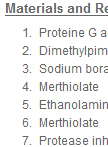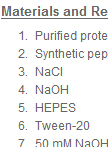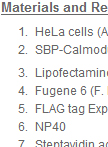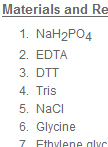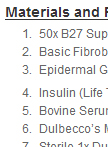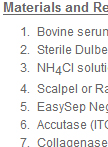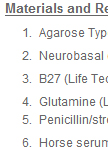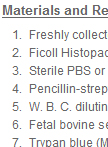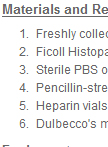Improve Research Reproducibility A Bio-protocol resource
- Protocols
- Articles and Issues
- About
- Become a Reviewer
Past Issue in 2013
Volume: 3, Issue: 3
Biochemistry
ImmunoPrecipitation of Nuclear Protein with Antibody Affinity Columns
Co-Immunoprecipitation (Co-IP) is the method used to pull down protein partners of a protein of interest using an antibody that specifically binds to this specific protein in order to test protein-protein interaction. “Pulled down” proteins can be analyzed by western blot for suspected protein partner, or by Mass spectrometry for high throughput protein partner identification. The advantage of this technique is that endogenous protein partners can be identified from cell lines that naturally express these factors.This protocol is optimized for hard-to-extract nuclear proteins, e.g., that stick to the nuclei inclusion bodies / nucleosome complexes such as TLX1 and TLX3 (Dadi et al., 2012). Most often, these factors are not soluble when using classical protein extraction methods. We used to add nucleases in order to increase solubilization of protein complexes trapped within inclusion bodies; though the efficacy varies depending on the given protein and therefore has to be empirically determined.
Protein-peptide Interaction by Surface Plasmon Resonance
This protocol measures the protein-peptide interaction by surface plasmon resonance (SPR) using Biacore X100 (GE Healthcare). The Biacore system can monitor the direct interaction between biomolecules. There are several methods of immobilizing a ligand to the sensor chip. The optimal immobilization method for each experiment needs to be selected. In this protocol, we employed amine coupling to immobilize the protein to the carboxyl-type sensor chip. The procedure generally follows the “Instrument Handbook” of Biacore X100.
Co-Streptavidin Precipitation
Co-Streptavidin Precipitation (Co-SP) is a method to pull down protein partners of a protein of interest tagged with the streptavidin binding protein domain, and using streptavidin columns that specifically bind to Streptavidin Binding Protein (SBP) in order to test the protein-protein interactions. Proteins of interest to be tested for their interaction are artificially co-expressed in “easy to transfect” cells. Pull down proteins can be analyzed by western blot for suspected protein partner.
Purification of Antigen 85 Complex of Mycobacterium tuberculosis
Serodiagnosis of tuberculosis using purified native antigens is one of the approaches for the early detection of TB. The Antigen 85 complex consisting of Ag 85A, 85B and 85C are the most abundant antigens in the culture supernatant of mycobacteria. It has also been shown to be the immunodominant (the property of an antigenic determinant that causes it to be responsible for the major immune response in a host) antigens of CFA (culture filtrate antigens – proteins secreted by mycobacteria into the culture medium). This protocol gives the details for purification of the Ag85 complex from CFA and also the method of isolation of the individual components of the complex by column chromatography.
Cancer Biology
In vitro Tumorsphere Formation Assays
A tumorsphere is a solid, spherical formation developed from the proliferation of one cancer stem/progenitor cell. These tumorspheres (Figure 1a) are easily distinguishable from single or aggregated cells (Figure 1b) as the cells appear to become fused together and individual cells cannot be identified. Cells are grown in serum-free, non-adherent conditions in order to enrich the cancer stem/progenitor cell population as only cancer stem/progenitor cells can survive and proliferate in this environment. This assay can be used to estimate the percentage of cancer stem/progenitor cells present in a population of tumor cells. The size, which can vary from less than 50 micrometers to 250 micrometers, and number of tumorspheres formed can be used to characterize the cancer stem/progenitor cell population within a population of in vitro cultured cancer cells and within in vivo tumors (Lo et al., 2012; Liu et al., 2009). While several cell lines can be used for tumorsphere formation assay (e.g. primary mammary tumor cells from Her2/neu-transgenic mice, MCF7, BT474 and HCC1954), some cell lines may not form typical tumorsphere structures and may be difficult to count or classify definitively as tumorspheres.
Isolation of Cancer Epithelial Cells from Mouse Mammary Tumors
The isolation of cancer epithelial cells from mouse mammary tumor is accomplished by digestion of the solid tumor. Red blood cells and other contaminates are removed using several washing techniques such that primary epithelial cells can further enriched. This procedure yields primary tumor cells that can be used for in vitro tissue culture, fluorescence-activated cell sorting (FACS) and a wide variety of other experiments (Lo et al., 2012).
Developmental Biology
Organotypic Slice Culture of Embryonic Brain Sections
This technique will allow using brain slices to study several aspects of cortical development (i.e. neurogenesis), as well as neuronal differentiation (i.e. neuronal migration, axon and dendrite formation) in situ. This protocol is suitable for various embryonic stages (Calderon de Anda et al., 2010; Ge et al., 2010).
Immunology
In vitro Culture of Human PBMCs
Peripheral blood mononuclear cells (PBMCs) consist of chiefly of lymphocytes and monocytes. Purified PBMCs are used in vitro to evaluate a variety of functions of lymphocytes viz; a) proliferation to mitogenic (PHA, Con-A) stimulation, b) monitoring of prior sensitisation in antigen recall assays by scoring lymphocyte proliferation, c) immunophenotyping for surface markers as well as intracellular molecules in monocytes and lymphocytes etc. Activation of monocytes/macrophages by small molecules, cytokines and pathogen components can also be monitored. PBMCs can also be used for a variety of structural and functional studies for addressing issues in human immunology such as scoring for apoptosis and production of cytokines as well as other mediators in vitro.
Isolation of Human PBMCs
Peripheral blood mononuclear cells (PBMCs) are chiefly lymphocytes and monocytes. PBMCs are separated from the whole blood by a density gradient centrifugation method using Ficoll Histopaque.


